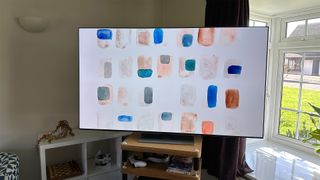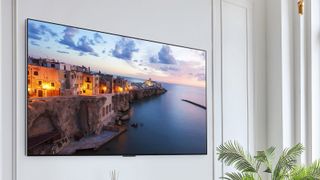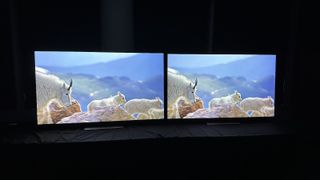LG's new G3 OLED is here and is an absolute cracker, as you'll see if you give our full LG G3 review a read. As part of that review, we compared the G3 to its predecessor, the excellent G2, and the results are fascinating.
Yes, the new model is capable of going significantly brighter than the old one thanks to its Micro Lens Array technology, but to what degree will you be able to make use of that extra brightness? And are there other ways that the G3 is superior to the G2, which was already one of the best TVs you can buy?
Most crucially, should you buy a G3 or pick up a G2 while it's still available?
It's those questions that this page is here to answer, so buckle up for one of the most important TV comparisons of the year.
LG OLED G3 vs G2: price

At launch, the LG G2 OLED range started at £2400 / $2200 / AU$4799 for the 55-inch model and topped out at £6500 / $6500 / AU$15,599 for the 83-inch variant. There is a 97-inch model, but it's a bit of an outlier with a super-premium price to match its bleeding-edge status.
The LG G3 retains the same 55, 65, 77 and 83-inch screen size options from last year's G2. However, there will not be a 97-inch G3 as LG has instead opted to carry over the 97-inch G2 into 2023.
Disappointingly, the G3 is priced higher at launch than the G2 was, as you can see from this breakdown:
| Size | G2 (2022) | G3 (2023) |
|---|---|---|
| 55 inches | £2400 / $2200 / AU$4799 | £2600 / $2500 / AU$TBC |
| 65 inches | £3300 / $3200 / AU$6359 | £3500 / $3300 / AU$TBC |
| 77 inches | £4500 / $4200 / AU$11,399 | £5000 / $4500 / AU$TBC |
| 83 inches | £6500 / $6500 / AU$15,599 | £7500 / $6500 / AU$TBC |
| 97 inches | £25,000 / $25,000 / AU$39,995 | N/a |
Of course, while the price above is what you'll actually have to pay for a G3, seeing as it's brand new, the G2 is now available for significantly less than it was at launch (you'll see the latest, lowest prices below), making this round an easy but predictable win for the older model.
** Winner: LG G2 **
LG OLED G3 vs G2: build

There's almost nothing to separate the G3 and G2 in design terms. The stepped design to the edges that was introduced last year returns so that there’s a slight gap between the set’s edges and the wall even when using the so-called Zero Gap wall mount (this is a new name but the mount itself is the same), but otherwise both sets have a uniform thickness of just 2.4cm.
In both cases, the wall mount comes in the box but a pedestal stand does not. This will be a point of frustration for a lot of buyers, particularly as the official pedestal stand will set you back around £100 / $150 / AU$300. You can at least opt for a cheaper third-party stand that connects to either set's VESA mounting points if you prefer.
The one difference that is visible when you have the G3 and G2 side-by-side is that the G3’s screen, when off, has a slight bronze tint. That’s because it has a new and significantly more effective anti-reflective coating. With the set switched off, you can of course see some reflections on the screen, but they’re significantly less pronounced than those on the G2 and it’s very rare indeed that you’ll spot any when watching a movie or playing a game.
Essentially, these two sets look almost identical, but that new anti-reflective coating on the G3 is enough for it to take this round.
** Winner: LG G3 **
LG OLED G3 vs G2: features

The big talking point is, of course, the G3's new Micro Lens Array (MLA) technology, which allows it to hit peak brightness figures that previous OLEDs, the G2 included, could only dream of. We'll cover that properly in the picture section, below.
With each year comes a new processor, and so it proves here, with the G3 being powered by the Alpha 9 Gen 6 rather than the G2's Alpha 9 Gen 5. The differences aren't huge, but the new processor does offer a handful of new features, including AI Super Upscaling Pro, which is designed to upscale sub-4K sources while reducing noise but preserving intentional film grain; OLED Dynamic Tone Mapping Pro, which breaks the image down into 20,000 zones (rather than the 5000 of before) for separate HDR optimisation; Object Enhancer, which sharpens foreground characters and props; and HDR Expression Enhancer, which applies specific tone mapping to those foreground elements.
On the audio front, the new Alpha 9 Gen 6 chip adds up-mixing of all sound formats to 9.1.2 (up from 7.1.2 last year), and a new Auto Balance Control feature that attempts to prevent certain frequencies from being drowned out by others so that, for example, midrange voices aren't smothered when bass increases. You can also now use the TV's speakers in conjunction with those of an LG soundbar using something LG calls WOW Orchestra.
The other notable change for the G3 is to the webOS operating system, which has been reduced down to just two pages from the multiple pages of before. The G2 could get a bit sluggish as you scrolled down through the pages, but the G3 is snappy throughout.
In order to condense the operating system down to just two pages, LG has introduced 'cards', which essentially act as folders for related apps and features. It's a system that works well, but the row of cards is a bit to prominent – we think it should go beneath the 'trending' and app rows. Overall, though, the webOS refresh is a welcome one, and it also comes with a more user-friendly and customisable quick menu for adjusting settings on the fly.
There are no significant changes to gaming features, but that's because there didn't need to be. Both the G2 and G3 support every next-gen gaming spec out there, including 4K/120Hz, VRR and ALLM. There's also a Dolby Vision game mode that works right up to 4K/120Hz, plus an HGiG mode for more accurate tone mapping with many HDR games. Input lag is for both models is around 13ms for 60Hz content. You can reduce this to under 10ms if you enable the Boost mode from the Game Optimizer menu.
MLA aside, the G3's feature upgrades over the G2 aren't huge, but they are enough for it to win this round.
** Winner: LG G3 **
LG OLED G3 vs OLED G2: picture

Let's kick off this round by first acknowledging what an excellent TV the LG G2 is. By combining an OLED EX panel with a heatsink and, of course, LG's own advanced picture processing, the G2 was able to go brighter than any OLED TV before it.
On the one hand, the very brightest ‘peaks’ of an HDR image have lovely purity, brightness and ‘gleam’. We’re talking here about such things as sun reflecting off metal; shots of the moon or street lights against a black sky; stars, raindrops and so on. Also, though, the overall brightness of light, full-screen HDR content is superb, too, making such pictures look more realistic and ‘HDR’.
Despite the brightness of its highlights, blacks are just as inkily black as we've come to expect from OLED, but the G2 also digs up more shadow detail than most of its rivals and contemporaries.
Overall, the G2 produces is brilliantly rich and expressive, which in turn enhances their sense of depth/three-dimensional space.
The G3, though, is even better. The addition of MLA technology allows it to go significantly brighter. Admittedly, you'll only see the 2000+ nit peaks that were promised if you brave the garish Vivid mode, but the set will still hit almost 1500 nits in its more conservative and more cinematically authentic Cinema and Filmmaker Mode presets. Of those two, it's Cinema that we prefer: Filmmaker Mode might be capable of delivering bright highlights but it's a bit on the dull side overall – more so than the G2, in fact.
In the Cinema preset, the G3 is a stunner. The extra brightness is clear and, contrary to some predictions, there's extra vibrancy to bright colours, too, so the image pops beautifully.
In every way bar one, the picture of the G3 is either as good or better than that of the G2. That one exception is colour vibrancy in low-light scenes. For some reason, shadowy parts of the picture are rather pale on the G3 despite having plenty of saturation on the G2.
It's not a clean sweep in the picture round for the new model then, but it's close. The G3 is in most ways last year's excellent G2 made even better.
** Winner: LG G3 **
LG OLED G3 vs G2: sound

Now here's a turn-up for the books: the new G3 actually sounds worse than the G2 it replaces. LG has always struggled to get the audio of its OLED TVs right but the G2, while not perfect, was a step in the right direction, proving pretty punchy and engaging.
For some reason, the company seems to have gone the other way with the G3, which is rounded off to the point of being dull. Detail levels are similar, as are dynamics, but there's little punch or definition to sound effects. Both TVs can be prompted to distortion by deep bass, too.
Ultimately, both TVs are crying out to be partnered with a soundbar – without one you really won't be doing justice to the glorious imagery – but this round still, surprisingly, goes to last year's G2.
** Winner: LG G2 **
LG OLED G3 vs G2: verdict
Last year's G2 was and still is an excellent TV, but there's no denying that the G3 is a pretty big upgrade. Yes, there's a slight loss of colour volume in dark parts of the picture and the sound is disappointing, but in every other way the new model is the same or better, with the biggest upgrades being the increases in brightness and bright colour vibrancy, which have benefits right across the picture.
There is still, of course, an argument for buying a discounted G2 rather than a full-price G3, and there's a lot to be said for that if you need a new TV right now, but our advice would be to hold on for the G3 to hit a price that works for you. It really will be worth the wait.
** Overall winner: LG G3 **
MORE:
Read the full LG G3 review
Here's how the LG G3 vs G4 (2024) compare
And here's the complete LG 2023 OLED TV lineup

